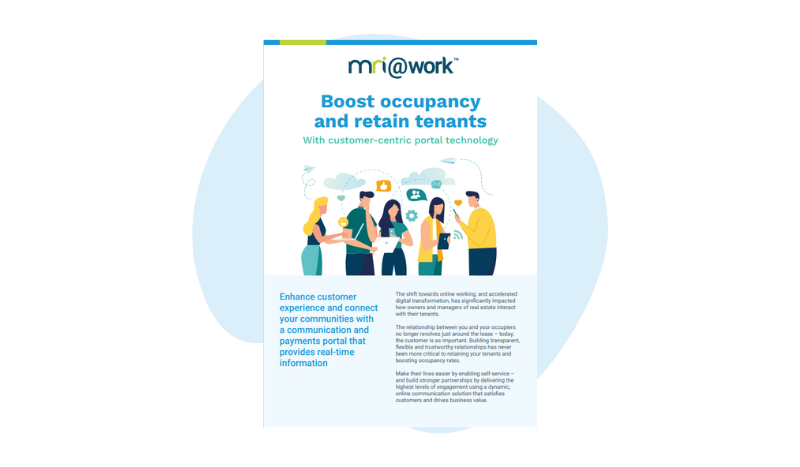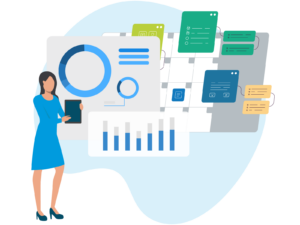Reinventing the multifamily enterprise
In a recent post, we discussed the demise of the multifamily leasing office, driven by accelerated technology adoption as a result of COVID-19. The main point being that with today’s technology, much of the work associated with the leasing office no longer needs to be done on site. When you ask yourself where it should be done, you find a unique opportunity to reshape the multifamily enterprise in ways that will better serve prospects, residents and site staff.
Broadly, work typically conducted on site can be grouped into the following categories:
- Marketing, Sales and Leasing – advertising the property and available units, pricing, prospect engagement, lease execution, move-in inspections
- Resident Service – servicing existing residents’ concerns, intake of maintenance requests, lease changes for roommates/pets/rentable items, package handling, amenity reservations, lock outs, notice to vacate processing, move out inspections
- Billing and Collections – processing monthly rental collections, driving online payment adoption, sending late notices, managing eviction and collection processes, SODA processing
- Renewal Processing – generating renewal notices and processing renewals
- Site Service and Vendor Management – coordinating with the maintenance service team on unit turns, service request processing, vendor contracting and scheduling, renovation planning as well as safety, security and emergency preparedness
- Reporting, Budgeting and Forecasting – managing the property P&L, forecasts for revenue and expenses and future year budget creation
In the current highly decentralized model for most multifamily operators and managers, many, if not all, of these activities are performed on site by a relatively small team of employees. As such, these employees become jack-of-all-trade-types, spanning from high-touch customer service to detailed financial analysis and resident accounting. On-site staff typically have high attrition, with national averages hovering around 33%.
As we have proven that we can separate the property office work from the property office, we are given an opportunity to rethink how to better organize to get the work done.
Advantages of centralization and specialization
We can now leverage technology to perform traditional on-site activities remotely and we can organize around process or function. We can create specialists who excel in their area of focus by leveraging their core strengths. We can create more career paths and growth opportunities. We can further leverage technology to drive efficiencies.
- Marketing, Sales and Leasing – A centralized sales-focused function would drive lead generation and lease conversion. The people in this role would facilitate video and self-guided tours while also being available for in-person tours as requested. They will ensure that applications are completed, application fees are collected, screening results managed, and lease documents executed, typically in an electronic format. These sales professionals would become product experts and closers. They would be measured on lead generation, leasing velocity, pricing compliance, and customer satisfaction. The pricing function in many organizations is already centralized and enabled by revenue management technologies.
- Resident Service – A centralized customer service-focused team would be the contact point for current residents and be well versed in the variety of services and resources that are available for residents. A resident service team would be a gateway to amenities, local discounts, social programs and additional concierge services. They would track and log all resident requests and concerns for appropriate follow-up. They would facilitate changes to existing leases due to roommate changes, pet additions and the rental of other items (parking/storage). They would also manage all courtesy activities including package notifications and lock-out assistance (especially if the digital locks are in place). They would be measured on customer satisfaction, renewal retention and their ability to drive ancillary revenue through amenity and service utilization.
- Billing, Collections and Renewals – A centralized resident accounting-focused team would manage all billings and prorations, renewal offers and negotiations, vacate notices, SODA preparation and processing, late fees and late notices, as well as managing eviction and collection processes. This group would also drive online payment adoption. They would be measured on arrears and bad debt, online payment adoption and renewal effectiveness and NTV reversals.
- Site Service and Vendor Management – A centralized team for vendor management and site service would drive procurement best practices for goods and services in coordination with site maintenance staff. Metrics would include turn duration and cost per turn, improved pricing through volume contracts, and renovation project timeline and budget. Additional processes and metrics on property quality, safety, security and emergency preparedness would be monitored and tracked.
Centralizing these functions will create more specialization and focus on each. Focus will lead to process improvements as well as the ability to leverage economies of scale and to adjust staffing levels to best cover peak and low volumes times. Each role will attract staff whose skills are aligned to the unique requirements of the job. Centralized teams will naturally have internal career paths and cross-organizational career paths may also emerge. Attrition should reduce as role expectations are consistent and well documented within each area.
Some physical presence required
Beyond the activities of the leasing office, there will continue to be tasks that require staff to be onsite. This, however, does not mean that the staff needs to be on site full time. They just need to be in reasonable proximity. This will create opportunities for regional offices, sometimes called pods, as central points for leasing and maintenance staff.
Much like working with a real estate agent when purchasing or leasing a single-family home, the leasing agent will meet the prospect at the property to facilitate a tour at a pre-scheduled time.
Maintenance work can also benefit from a regional pod as inventory can be shared across properties, trade skills can be deployed to the best-suited jobs, resources can be cross trained across properties and a larger pool of resources can be leveraged for on-call and other emergency situations.
Impacts on current technology providers
As more activities become centralized, users may encounter challenges in how current software systems operate. Many property management systems are built around the property construct with limited capability to drive processes centrally, across many properties, in bulk.
Before adopting central processing, users should assess how to best enable the new processes with their existing technologies.
Emerging technology for centralized operations
There are many new technologies finding traction in multifamily properties, and they all have the ability to further the remote management of properties. A few to consider include:
Smart Home Technology:
- Gate systems, smart door locks and other access fob systems will allow for remote management of property access, the ability to remotely solve lock out issues and the ability to enable resident and guest access to the property, amenity spaces and units themselves
- Water sensors and usage sensors will automatically alert to out-of-norm usage patterns signaling leaks or the need for usage-based preventative repairs
- Smart parking systems can understand if authorized cars are parked in authorized locations, provide guidance for handicapped parking and reduce the need to search for open spaces
AI & Chat bots:
- Teams no longer have to answer every call or chat as chat bots are able to answer routine and repetitive questions while still gathering important information on leads and service opportunities
- AI tools can interrogate repetitive documents, like proof of insurance, and appropriately extract data for storage in systems of record for further events and processing
Drones:
- Exterior conditions can be assessed without walking the site by leveraging drones covering predefined paths throughout a property to ensure quality and safety standards are met and creating a more thorough documentation of property condition from one visit to the next
A transformation opportunity
The multifamily industry is at a pivotal moment where long-standing processes and methods have been interrupted and new ones quickly put in place, often further leveraging technology. Before automatically reverting to how things were, organizations should assess opportunities to transform their operations and determine what can work better in a less traditional and highly decentralized manner. There is great opportunity to unlock better prospect engagement, customer service and employee satisfaction, all of which will contribute to a better bottom line.
MRI Engage for @Work Brochure
Enhance customer experience and connect your communities with a communication and payments portal that provides real-time information The shift towards online working, and accelerated digital transformation, has significantly impacted how owners and …

